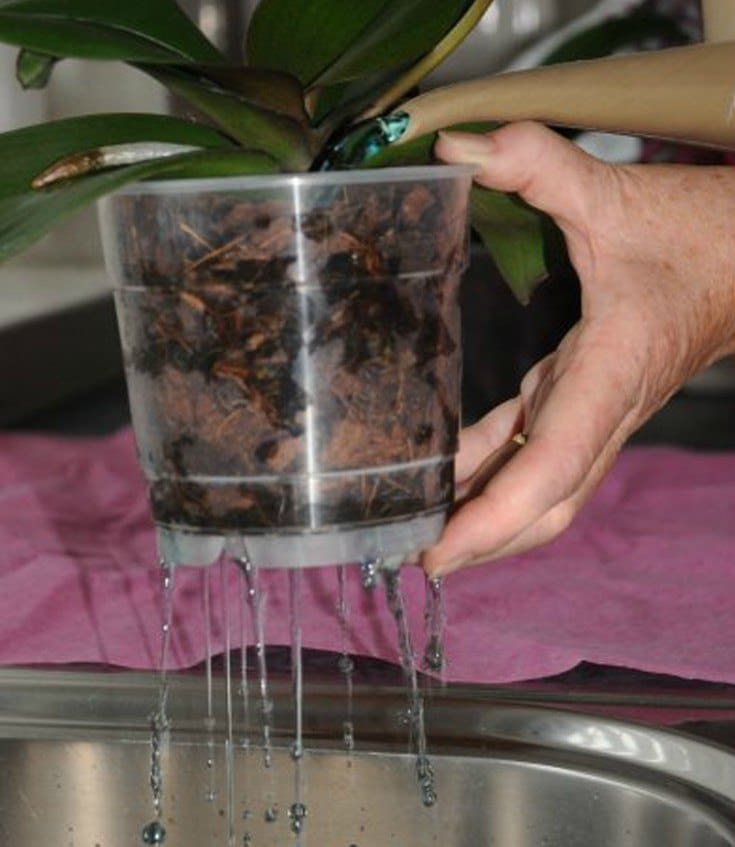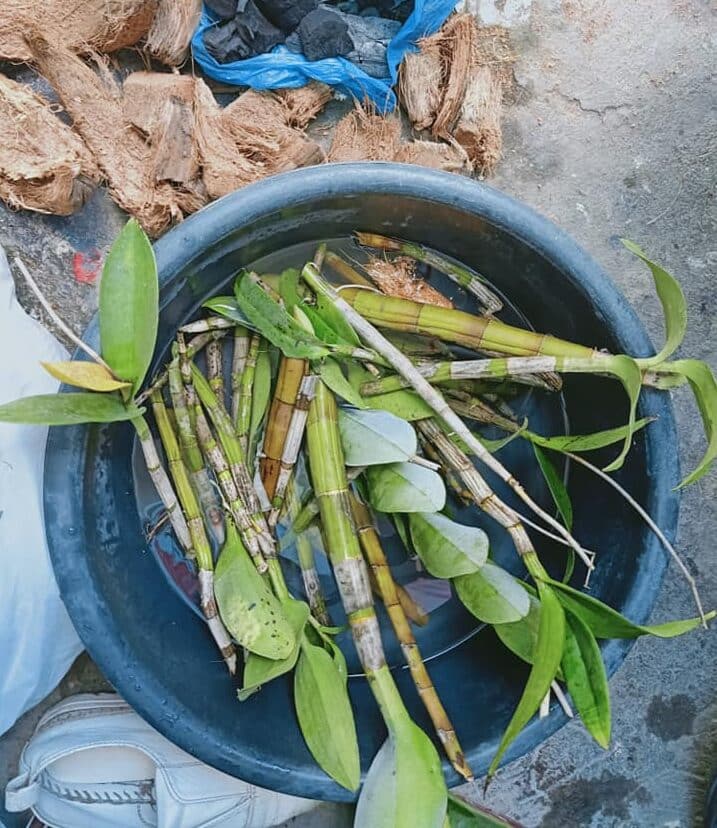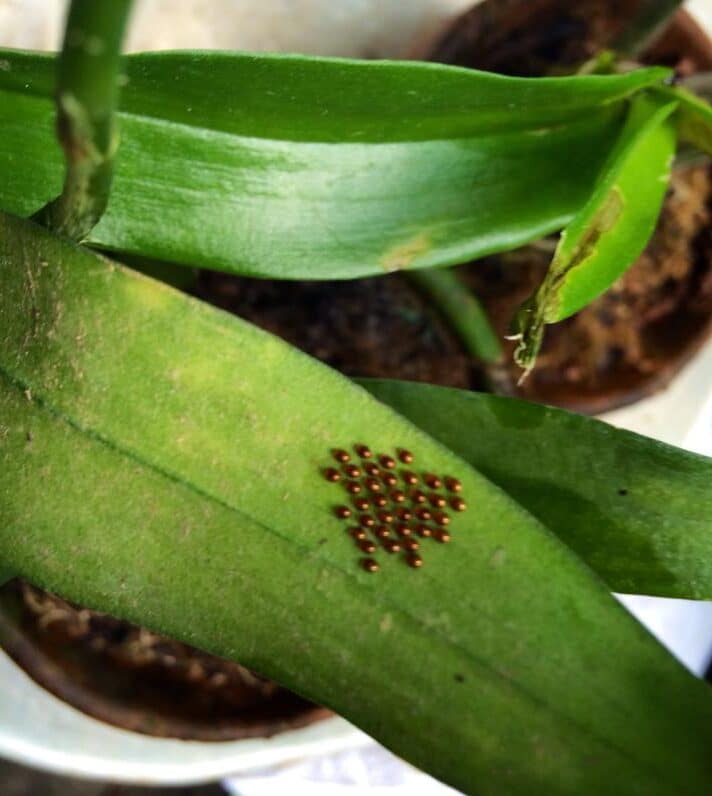Orchids are tropical plants that rarely get yellow leaves. Preparatory Orchid care saves the plant from sudden and severe foliage discoloration.
The reasons behind Orchid leaves and stem turning yellow are many. Learn the fail-safe tips to tend and save their leaves below.
Table of Contents Show
Orchid Leaves Turning Yellow [Is it Normal?]
Orchids come in evergreen and deciduous varieties, with individual plants living for 15-20 years before giving up to old age.
For the deciduous type, it’s normal for the Orchid flower and leaves to turn yellow and fall in winter.
Also, it is natural for the older Orchid leaves to turn yellow from aging.

If your Orchid’s top leaves start turning yellow during the active growing season and the Orchid flower falls off, act immediately and monitor the underlying problems.
But, Orchid leaves turning yellow at the base indicates the plant is beginning to shed spent foliage and space for new leaves.
Additionally, Orchids stay dormant between blooming seasons and look miserable with droopy and yellow foliage.
Why are my Orchid Leaves Turning Yellow?
Any anomaly in the care routine can cause yellow leaves in Orchids.
Let’s look at some mishaps and solve the problem by offering solutions below.
1. Improper Watering
The most common mistake many gardeners make is improperly watering their Orchids.
In contrast to underwatering problems, overwatering tends to be riskier due to root rot.
Rotten roots cannot deliver the necessary nutrients for plants and cut off the oxygen supply, leading to the Orchid leaves turning yellow and brown.

Furthermore, overwatering leads to soggy soil conditions, encouraging fungal growth.
A relatively healthy Orchid lasts 2-8 weeks without water, but it depends on the variety and surrounding humidity.
Thus, underwatering issues in Orchids occur if you let the plant go dehydrated for over a month.
How to Fix?
- Stop watering your Orchid and let the soil dry by keeping the plant in direct sunlight.
- Carefully inspect the roots for rots by pulling the plant from the pot and pruning decaying foliage.
- If you spot mushy roots, snip them off using sterilized pruners and apply neem oil to the cut ends to discourage fungal growth.
- Use a fresh suitable potting mix with medium water retention if the soil smells foul or fishy.
- Poke holes in the topsoil for aeration and add organic perlite to increase the porosity.
- Thoroughly water your Orchid via the bottom watering approach.
- Check the top 1-2 inches of soil using finger dip tests before watering the plant during dormancy.
2. Excessive Light
Another primary culprit behind the yellowing Orchid leaves is prolonged sun exposure, increasing the surrounding temperature.
In their natural habitat, Orchids are often found growing under the shade of other big trees, avoiding scorching light.
They can withstand at least 6 hours of direct sunlight and grow with 12-14 hours of grow light exposure.
Under direct sun, Orchid leaves attain black spots and light brownish blotches due to sunburn.
Likewise, avoid placing Orchids in completely dark areas. Light-deprived Orchids can get yellow leaves followed by stunted or leggy growth.
How to Fix?
Here is how to stop Orchid leaves going yellow.
- Hang your Orchids near an east-facing window or 3-5 feet from a south-facing window.
- Keep a few inches of gap between the window panes and leaves.
- Use curtains or UV light panels to reduce the light intensity as a shield to protect the sensitive leaves.
- Keep the plant 6-12 inches from artificial lights to prevent yellowing leaf tips and edges.
3. Irregular Fertilization
Orchid is a hungry flowering plant that prefers a fertilizer typically of a quarter or half the concentration of the original mix.
However, they prefer to stay under-fertilized rather than suffer from excessive fertilization.
The sensitive roots of Orchids are highly susceptible to fertilizer burn due to excessive fertilizer in the soil.

Overfertilization causes nutrients (fertilizer salts) to stockpile in soil, making it toxic.
That’s why the fertilizer burnt roots cannot serve their purpose, which induces nutrient deficiency and yellowing leaves.
Likewise, under-fertilizing your Orchids causes nutrient deficiencies and Orchid leaf discoloration.
How to Fix?
- Flush the excess salts by washing the potting soil monthly to prevent salt accumulation.
- Diagnose the roots and prune off dying, brown or black, damaged roots.
- Water before fertilizing your Orchids for the nutrients to reach the deeper soil layers.
- Use a gardening trowel to flake off the encrusted salt layers from the topsoil.
- Avoid fertilizing dry plants, as the salts can burn the roots.
- Apply 1 teaspoon of Epsom salt to a gallon of water and give it to the plant monthly to keep its leaves green.
4. Temperature Stress
Orchid is a beautiful tropical flowering plant thriving in a warmer environment.
Meanwhile, the plant does not stand cold drafts, initiating the bottom leaves of the Orchid turning yellow starting from the top.
Similarly, frost damage in Orchids can lead to bacterial root rot affecting the plant’s health.

In contrast, hot spells can cause the Orchid to droop or wilt, with leaves turning brownish-yellow or pale.
Sometimes adjusting the humidity levels to the changing temperature can save Orchids from getting yellow leaves.
How to Fix?
- Locate the plant away from drafty north-facing windows to avoid temperature drops in fall and winter.
- Cover the plant with frost blankets and place heating pads under the pot to keep the warmth intact, protecting it from winter.
- Relocate Orchids away from radiators, air vents, and conditioning accessories.
- Place the plant on a moisture tray to offer optimum ambient humidity.
- Add an extra layer of mulch on top of the potting mix to provide insulation for the plant in winter.
- Mist the leaves once a week during the dry streaks in summer. Wipe out any water drops from the leaves.
5. Repotting Stress
Orchids are low-maintenance plants with a simple repotting routine.
However, they may go under repotting stress, which is a probable reason for Orchid leaves turning yellow.
Repotting stress is typically due to sudden changes in potting mix, temperature, air circulation, or humidity.

The plant will reveal droopy leaves with yellowing signs if you fail to give them a well-draining soil mix with high water retention.
And improper repotting during the flowering spell can cause Orchid leaves to turn yellow. The situation can worsen to Orchid flowers falling off if you fail to address them.
Moreover, the foliage might turn brown, rendering a wilting plant.
Tips to Repot Orchids
- Work with a dull knife around the potting soil and carefully tug the Orchid out from its pot.
- Untangle the cramped roots and inspect for infection to remove them.
- Take a 1-2 inches wider terracotta planter or ceramic pot with holes and fill it one-third with a suitable potting mix.
- Settle the plant in the new pot and arrange the roots. Add some more soil from the sides.
- Keep the plant in dappled light until it recovers from repotting stress.
- Lightly mist the Orchid leaves in the morning hours for a few weeks after repotting.
6. Pests & Diseases
Bugs and pathogens hitch a ride on the Orchid leaves if you use the wrong water for irrigation and keep your houseplant untidy.
Pests feast on the plant by sucking out nutrients, causing the leaves to turn yellow, distort, and stunt.

Moreover, the infected area is speckled with sticky liquid or honeydew in case of severe pest infection.
The infection might extend to other plant parts during the disease incidence, rendering them functionless.
How to Fix?
- Isolate the infected plants from other healthy ones to prevent the spread of outbreaks.
- Use blasts of water to cast off the pests from the plants.
- Take Q-tips dipped in neem oil to dab the pests and prune off the infected leaves all the way from the base.
- Dispose of the plant parts by burning them down.
- Employ copper-based fungicides to salvage a severely diseased Orchid plant.
- Groom your Orchids after the flowers fall off the plant to provide better air circulation and space for new leaves.
Should You Cut Off Yellow Orchid Leaves?
Orchid leaves turning yellow are incurable, as they cannot turn back green.
Therefore, in most cases, it’s advisable to discard those damaged leaves to save energy.
If the leaf has naturally turned yellow completely, it will fall off soon.
However, you shall trim off those leaves infected with bacterial and fungal diseases.
From Editorial Team
Nutrient Supplement!
Dropping yellow Orchid leaves may be a sign of potassium deficiency.
At such times, your Orchids need a good blend of potassium-based fertilizer.


